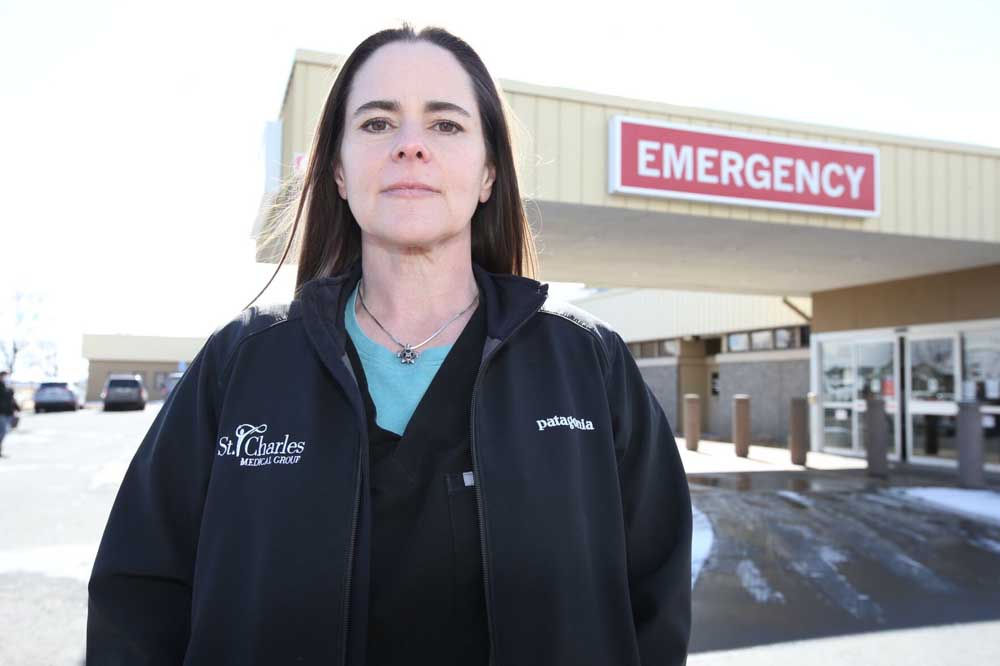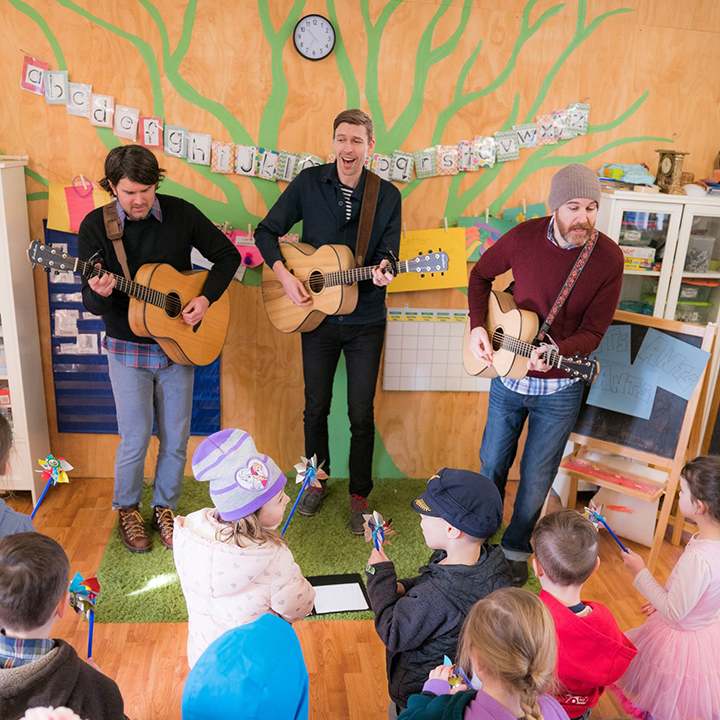Finding common ground: Meeting Oregonians where they are on gun safety
Published 6:30 am Sunday, March 12, 2023

- Dr. Torree McGowan stands outside the emergency room entrance at St. Charles in Redmond. McGowan works at emergency departments in Madras, Redmond and Prineville.
When someone with an accidental gun injury comes into Dr. Torree McGowan’s care at one of St. Charles’ emergency departments, she knows there’s already been a missed opportunity.
Whether an opportunity to talk about safe gun storage or an opportunity to ask tough questions about mental health, McGowan said many of the gun injuries she sees could have been prevented.
“(It’s) kind of like teaching somebody to put on a seatbelt after they’ve already had the car accident,” McGowan said. “When I talk about safe storage and firearms is actually when I take care of kids that have accidentally gotten into a bottle of somebody’s medicine that they shouldn’t have gotten into. And I use that as an opportunity to talk about (how) we need to store all of the things that are home safely.”
She also has conversations about where guns are stored with patients experiencing mental health crises, noting that many gun shops are willing to temporarily store a person’s guns as an alternative.
Most people don’t want to be lectured about guns by someone who doesn’t know what they’re talking about, and many clinicians don’t talk to their patients about guns because they themselves don’t know enough about them.
“To me, the part that’s unfortunate about that is we lost the ability to have this conversation in a respectful manner,” McGowan said. “Unfortunately many firearm owners feel very threatened by that conversation.”
But McGowan has a different approach. She tells her patients about her the firearms she owns, how she grew up in Myrtle Creek shooting .22s starting at age 6, and her Air Force deployments in Iraq and Afghanistan, and those conversations become much easier.
“The way that we make this work better is meeting people where they are,” McGowan said.
The story of people injured by guns in the world’s most heavily armed country often ends in an emergency department like McGowan’s.
Rarely does it begin there. More often, it begins on one side of a deep divide, a chasm of differing opinions rooted in fear, disparate personal backgrounds and strongly held understandings of American values.
It is this divide, experts say, that communities must build bridges across to change course in a country where firearm injuries kill thousands of children a year.
And while the divide may seem at times unbridgeable, it isn’t. Oregonians are finding common ground across the divide through a shared focus on reducing injuries and deaths and through challenging conversations about the responsibility it takes to own a gun.
In Oregon, most gun deaths are suicides
Well-known fatalities from guns are those that top the headlines, from events of mass violence like the Bend Safeway shooting to sporadic shootings on Portland streets. The seeming frequency of these newsworthy shootings — there have been over 100 mass shootings nationwide in 2023 according to Gun Violence Archive — leaves the impression that the most common reason people are killed by firearms is that they’re shot by someone else.
But fatality data suggests otherwise, especially locally: Four in fives deaths by firearm in Oregon are suicides, according to federal injury data. Nationwide, suicides make up just over half of all firearm deaths.
Most gun injury deaths come from handguns in Oregon, according to data from the Oregon Health Authority. Emergency department visits related to firearm injuries have been on the rise in the state in recent years, from 534 in 2018 to 873 in 2021, according to research from a new multi-agency collaborative studying the issue.
The collaborative, called the Oregon FASTER Project, which stands for Firearm Injury Surveillance Through Emergency Rooms, is a unique research partnership between Oregon Health & Science University, Portland State University and the Oregon Health Authority. Since 1996, Congress has prohibited the Centers for Disease Control and Prevention from funding gun violence research, but a 2019 policy change has made that research possible.
To Kathleen Carlson, the researcher who runs that collaborative, those figures signal that injuries from guns equate to a public health crisis. She breaks the injuries down by whether they’re intentional or accidental and whether they’re self-inflicted or not.
Still, there are commonalities across all those categories: Many injuries involve substance abuse and often-unintentional access to firearms.
“We also see hopelessness that kind of connects firearm suicides with firearm homicides. Financial hopelessness and mental health and the ‘deaths of despair,’ as we started to call them in 2020, are definitely a common factor as well.”
Despite those figures suggesting a crisis, Carlson’s view of the issue as one of public health means she looks for solutions. Carlson points to the parallels with what was once an epidemic of car crash fatalities as an example.
“In motor vehicles, we look at the roadways. We look at the vehicle safety itself. We look at the environments — the time of the day, the weather patterns. We look at the individuals: What is their level of training? Are they ready to drive a vehicle, something that’s inherently dangerous to themselves and to others? What are the other ways that we can nudge individual drivers to be safer, whether incentive-wise or policy-wise or whatnot?”
In a similar vein, Carlson’s team suggests a number of public health strategies that could be employed to reduce injuries and deaths from guns, including criminal justice reforms, improving neighborhood safety, training outreach workers and community members to identify the signs of possible violence or mental health crises, providing easy access to mental health treatment and more.
On a sensitive topic, the messenger matters
Still, one key part of making interventions like those works is who’s a part of the conversation, according to Michelle Barnhart, a marketing professor at Oregon State University.
“There’s a defensiveness of, ‘people who don’t know anything about guns or trying to tell us what to do with our guns.’ And it’s to some extent a fair criticism,” Barnhart said. “You have to speak your audience’s language in order to get them to believe in you.”
Barnhart is intentional about incorporating that reality into her research: She’s a gun owner who grew up in a rural community, while her research partner didn’t have any experience with private gun ownership prior to doing the research. Pairing up allows the researchers to connect with both gun owners and gun regulation advocates on either side of the divide, she says.
The problem of reducing deaths and injuries from guns is what Barnhart says researchers call a “wicked problem,” or a problem that’s particularly complex because people don’t just disagree on how to solve the problem, but how to define the problem in the first place. Because the right to gun ownership is enshrined in the constitution — the country’s foundational document — the argument is more existential than most other issues.
“So that’s a pretty big chasm, of, ‘we should make it harder to get guns’ versus ‘we should let all the good guys have guns.’ Now, there’s still some common ground in there,” Barnhart said. “And again, if you get away from the people who are really at the extremes yelling at each other and you move a little bit more toward the big group of people who are more in the middle, you are more likely to find consensus among at least maybe 65% to 70% of Americans on some particular issues.”
Shannon Monihan, owner of a firearm training company called Red Frog Team and the executive director of the Downtown Bend Business Association, looks for that common ground when she offers her training services.
Particularly, she says she’s looking to train women who live in homes with firearms but might not know how to use them. She focuses specifically on training people to use their guns for self-defense in the event of an assault or home invasion.
“I wanted to be a champion not of whether or not you carry. Okay, that’s all your decision,” Monihan said in an interview. “Let’s talk about safety.”
In defensive situations, Monihan frames guns as tools that are better to be informed about than not.
“Whether you’re left or right — just like a stick shift, if your child breaks their arm and you need to know how to use the stick shift in the car because that’s the only car in your driveway — it’s about making sure everyone understands gun safety,” she said.
For some gun enthusiasts, middle ground is lifesaving
Kerry Spurgin finds common ground around a statement everyone can agree on: No one wants to lose a friend or loved one to a firearm death. The president of the Oregon Sports Shooting Association, Spurgin often reminds people that so many gun deaths impact people in the gun-owning community.
“This is not gun violence in robberies and things like that which when I think of gun violence, that’s what I think. “This is our friends are hurting, and we want to save lives.”
Spurgin is a sports shooter, through and through. He’s been shooting in competitions for over 40 years on local, state and national teams and now heads the Oregon Sports Shooting Association.
He says a lot of his work leading the organization has been focused on safety, from promoting safe gun handling on ranges to educating members about safe gun storage. But when he met Donna-Marie Drucker in late 2020, that focus took a new direction.
“When we say we’re gonna talk about lethal means safety and suicide prevention, that’s a different conversation,” Drucker said. “And that was just a conversation that people kind of knew about but weren’t having on the level that they’re having now.”
Drucker was volunteering for Oregon’s suicide prevention hotline in 2020 when she had some spare time and asked if there was additional work she could be doing. She found herself reviewing transcripts from gun owner focus groups and looking to other states for ways to reach gun owners with suicide prevention messages.
“When I was having these conversations with gun owners, when I was doing the research on what would be the best suggestions, I could tell how hungry they were to be part of the solution, but nobody had asked them. Nobody had said, ‘let’s come to the table and let’s work together,’” Drucker said.
So she invited people to that table (a virtual table, as it was early in the pandemic) and formed the Oregon Firearms Safety Coalition with a focus on involving gun owners in conversations about suicide prevention. When Spurgin heard about it, he called Drucker, and the partnership between their two groups began.
Spurgin’s help — especially his connections with gun clubs — proved essential to Drucker’s ability to get in the door to those clubs and share her message. Now partnering with organizations in 20 of the state’s 36 counties, the pair tag-team trainings with gun club members about the risks of suicide, how to tell if a friend or loved one might be at risk and, most importantly, what to do about it.
The key is to put time and distance between a person who might hurt themselves and their guns (by offering to temporarily care for a person’s guns or getting them to a business or organization that will store them) and referring them to mental health or crisis services, the pair said.
Drucker’s personal story is an important part of building trust with training attendees, too. If people are skeptical about her message when she first comes in the door, she says they’re typically leaning into the conversation after she tells them how she’s the daughter of an English gunsmith, still shoots recreationally today — and survived a youth suicide attempt.
“I’ve never had a second attempt,” Drucker said. “Intervention works, support works. We know that. I also know that if I found my father’s handguns the night that I was trying to end my life, (there’s a) 90% chance I would have died.”
Drucker and Spurgin compare the OFSC training to CPR training: You might not expect to have a friend have a heart attack, but you’d want to be prepared if they do. You might not expect a friend to have a mental health crisis, but you’d want to be prepared if they do.
Central to the training the pair put on is making sure not to veer into political topics, which they say can cause people to get defensive or discourage conversation.
“I think we should all step back to, ‘We should save lives.’ We should shelve the question of whether or not guns are right or wrong — guns are here,” Spurgin said. “And it should come down to do we want to help our fellow citizen, our fellow friend, our loved one and are we prepared to do that?”
This story includes references to suicide. If you or a loved one are struggling with suicidal thoughts, help is available. Call the national Suicide and Crisis Lifeline by dialing 988, text SAVE to 741741 or call the Deschutes County Stabilization Center at 541-322-7500 ext. 9.
To continue the conversation about gun safety in Central Oregon, The Bulletin is partnering with the City Club of Central Oregon to host a discussion forum on the topic.
Bulletin Reporter Zack Demars will moderate the panel, which will include Michelle Barnhart, associate professor of marketing at Oregon State University; Shannon Monihan, CEO of Red Frog Team and executive director of Downtown Bend; and Dr. Torree McGowan, emergency medicine physician at St. Charles Medical Group.
The forum will take place in person at the RiverHouse on the Deschutes in Bend on March 16 at 11:30 a.m., and a recording will be available online after the fact. More information and registration details are available online at cityclubco.org.






